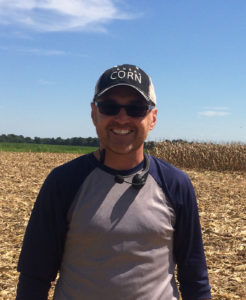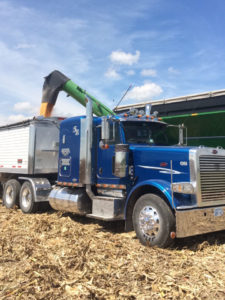From the Farm:
First to the field – Southeast Kansas Corn Harvest
Blog written by Leah Clawson

Chad Epler farms in Cherokee County, which is the farthest southeast corner in Kansas.
Corn is grown in all 105 counties in Kansas, but did you know it is typically harvested earlier in southeast Kansas? To figure out why that is, and to take a closer look at corn harvest in southeast Kansas. I traveled to Cherokee County, which is in the farthest southeast corner of Kansas, where I met up with Chad Epler. Chad’s family has been farming in Cherokee County since the 1950s, and are known as Epler Farms.
Chad explains the timeframe for producing corn in southeast Kansas, from planting to harvesting, “around here, a lot of farmers plant corn early in the spring, either late March or early April. The seeds are treated so even if they are planted too early, they sit in the ground without rotting. When the conditions are right, the seed will sprout and the plant will begin growing. We try to get an early start on planting, so we typically end up harvesting corn around Labor Day.”
Average rainfall and favorable temperatures also impact the corn’s growth. Many farmers in southeast Kansas, like Chad, do not need to irrigate their fields because southeast Kansas typically receives more rain on average than other parts of the state. To emphasize the role the higher amount of rainfall plays in southeast Kansas corn production, Chad adds, “Mother Nature controls our water. I think it’s pretty cool that we can raise 180 bushel per acre corn without the help of a sprinkler system.”
Did you know, not all corn seeds are the same? Different varieties of corn are designed to perform better in different climates and soils, and with different amounts of water. The different varieties also allow farmers to select different growing season lengths. In regard to using different varieties of corn, Chad says, “We plant different varieties of corn, including varieties that are shorter season corn and longer season corn. This helps us anticipate an approximate time frame for how long the growing season will be, and when the corn should be ready to harvest.”
Chad explains even though they have an idea of when the corn will be ready to be harvested based on the variety they plant, the timeframe can still vary depending on the amount of rain received and the temperatures during the growing season, as well as what the intended use for the corn is (e.g. the grain used for livestock and poultry feed or ethanol, the whole plant used for silage, the ear of corn used for earlage).
To know for sure whether the field of corn is ready to be picked, Chad, or one of his family members, walks into the field. They do this because moisture content is typically higher farther back in the field since the plants on the outside of the field receive more sunlight. They then shell a few ears of corn by hand, and take the corn to be tested for its moisture content. Chad says, “The moisture content of the corn is important to pay attention to when determining whether a field is ready to be harvested or not. We aim to have the moisture content in the corn kernel below 16%.” Too high of moisture in the kernel can cause problems, like molding in storage and spoiling other corn stored in the same bin.
Once a field is ready to be picked, it’s a team effort. Combines, grain carts and semi-trucks are all part of the scene. The combine’s header strips the ears of corn from the plant, leaving the rest of the plant on the ground in order to put the nutrients back into the soil. The combine also shells the kernels from the cob and stores the grain in its tank, sending the cobs back onto the field. When the combine’s tank is full, it is emptied into the grain cart, which is pulled by a tractor. The grain cart then hauls the grain to the truck. After the grain has been transferred from the grain cart into the truck’s trailer, the truck transports the grain to where it will be sold or stored.

The shelled corn is being emptied from the grain cart into the truck’s trailer.
Chad is the truck driver during harvest at Elper Farms. He hauls their corn to be sold at nearby, rural grain elevators. From there, the majority of their corn is sold to be used in livestock and poultry feed.
Even though it is past Labor Day, and the Epler family has finished picking corn, corn will continue to be harvested in different locations across Kansas for the next few months. When you drive across the state and see the progression of picked versus not-yet-picked corn fields, know there are multiple reasons corn fields are harvested at different times. To see harvest in action, follow Kansas Corn on Snapchat and Instagram (@kscorn), as we ride along with farmers.
